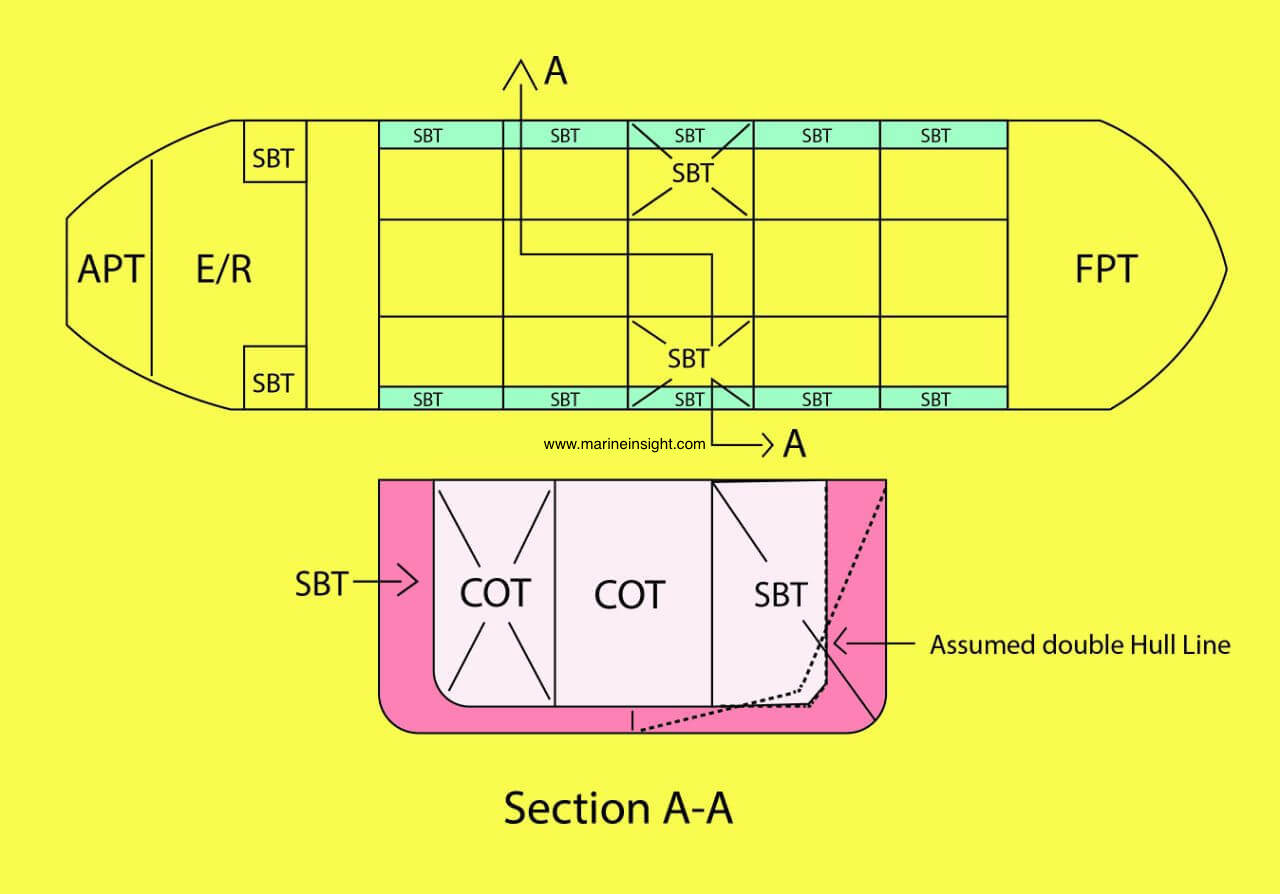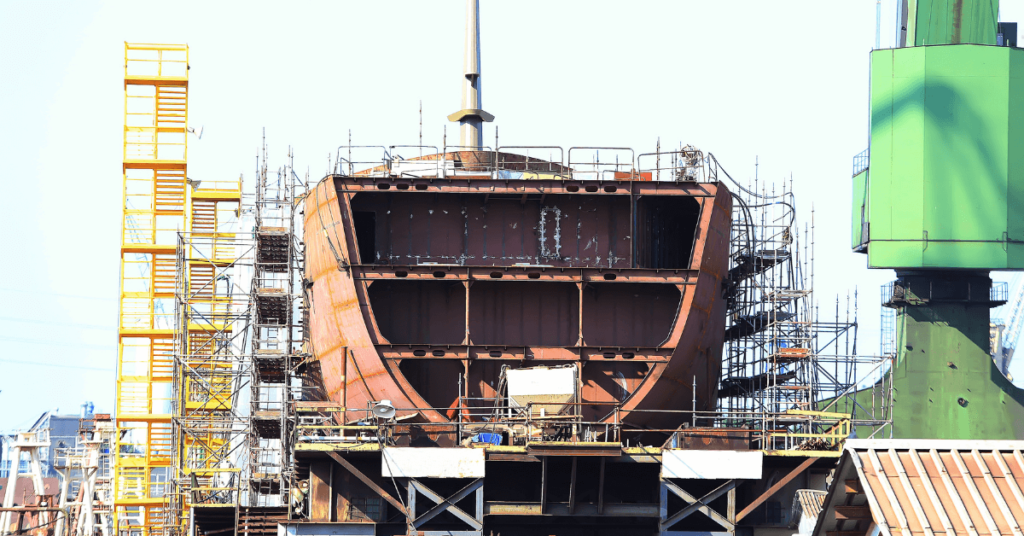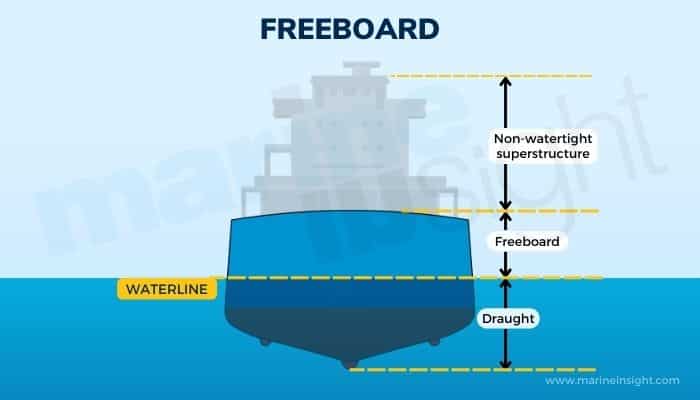A Guide To Ballast Tanks On Ships
During the designing and construction stages of a ship, the ballast tanks are introduced at various locations for maintaining the stability of the ship during the sea voyage.
The concept of ballast is not new and has been followed since ancient times. In the earlier times, the sea-going vessels used solid ballast such as sandbags, rocks, iron blocks, etc. which were loaded/unloaded once the cargo loading or discharge operation was finished. This method helped to a certain extent to maintain the stability of the ship and its seaworthiness.
However, today’s vessels carry liquid ballast, which includes fresh water, salt water or brackish water in various ballast tanks. As ships get bigger in size and the cargo carried by the vessels varies one port to another (due to global economics, ship condition, local voyage requirements etc.), water ballast tanks are used to compensate for maintaining the trim and stability of the vessel for a safe sea passage.

Why is Ballast Water Taken in the Tanks?
Let’s assume that the vessel does not have a ballast system. In such cases, the following conditions may arise:
- The propeller may not fully immerse in water, affecting the engine efficiency of the ship
- The ship may list or trim as the cargo capacity of the ship is not fully reached
- The shear and torsion loads on the vessel may increase the stresses on the ship structure, leading to bending moments and slamming
- The vessel may face issues of dynamic transversal and longitudinal instability
Related Read: Different Technologies To Measure Hull Stresses In Ships

To compensate for the above conditions, ballast water is taken on board vessels to ensure safe operating conditions during a specific voyage. It can be said that ballasting of ship fulfils the following:
- Ballasting of ship helps in reducing ship’s stresses on the hull of the vessel. It also provides for transverse stability of the ship
- As the propeller is submerged, it aids the propulsion plant in maintaining its efficiency
- Ballast helps in immersing the rudder, supporting the manoeuvrability of the vessel and also reducing the exposed hull surface
- The ship continually uses fuel and water from its tanks leading to weight loss. The ballast operation helps in compensating for the weight loss
Related Read: Everything You Wanted to Know About Ballast Water Exchange and Management Plan
Types Of Ballast Conditions
The Chief Officer and Master of the ship are responsible for adding or removing ballast water in the ship’s ballast tanks, depending on the ship stability condition. There are mainly three types of ballast conditions:
– Light Ballast: When the ship is heavily loaded, and it does not require an additional ballast, the water ballast tanks are kept empty. This condition is known as a light ballast.
– Heavy Ballast: During the seagoing state, if the ship is not fully loaded, ship ballast tanks are filled to its capacity. This condition is known as a heavy ballast.
– Port Ballast: Many ports around the world have a restriction for usage of ballast water. Dedicated port ballast tanks are provided to correct the trim and list of the ship during loading or discharging operation, and this is called port ballast.

Types of Ship Ballast Tanks as Per The Location
The water ballast tanks are provided at different locations depending upon the type of ship. Following are some of the most common locations for the construction of ballast tanks on ships:
Topside Tanks
As the name suggests, these are tanks are located on the topside corner of the ship. The topside tanks are triangular in shape fitted with wings on both sides of the cargo holds. They are more common in bulk carrier ships and are constructed using transverse frames arranged in the following ways:
1. A deck transverse under the main deck which supports the deck plating
2. Bottom transverse which forms the part of the supporting frame for the bottom area of the topside tank
3. Side transverse forms the part of the structure for supporting the side shell plating of the tank, which is kept in line with the side shell frames within the cargo holds (in single skin bulk carriers)
Related Read: Understanding Design Of Bulk Carriers
These tanks are directly connected to the ship’s main ballast pipelines and during the cargo loading/ discharging operation, the volume of the ship ballast water in the topside tank is kept in equilibrium with the cargo weight.
The design of the topside tanks helps in avoiding a shift of the cargo in inaccessible spaces for the grab as these tank designs help in carrying the cargo such as grain etc. without the need of a trim.
Lower Hopper Tanks
Similar in construction to the topside ballast tanks, these water ballast tanks are located on the bottom wing sides of each cargo hold of the ships, and they are kept in continuation to the double bottom tanks which run through the centre of the vessel. The hopper tanks provide the following advantages:
- They act as additional ballast space for the ship
- Their design offers slopes in the cargo hold corner which ease the collection of the cargo in the mid position of the hold for better discharging/stripping
- The adjacent fuel tank plating of the hopper tank forms a slant boundary to carry the static and dynamic load during cargo loading and ballasting.
Related Read: A Detailed Explanation on How to Operate a Ship’s Ballast System
Double Bottom (DB) Tanks
The double bottom of the ship is a safety feature to avoid ingress of water in case of grounding or collision. These void spaces are used to store ship ballast water to stabilize the ship.
The double bottom tanks are located between the forward part (till collision bulkhead) to the aft peak bulkhead, dividing the engine room.
In some ships, such as container and bulk ships, the double bottom space is divided transversely into three sections (instead of two). This is done to provide a cofferdam in the centre known as the duct keel’ which are used to carry ballast and bunker tank valves, and pipings for ships ballast tank and bunkering system.
The construction of the DB tanks is directly related to the length of the ship as the vessel with more than 120 m will have additional longitudinal framing in comparison with transverse framing for vessels of less than 120 m lengths.
Unlike upper topside tanks, these water ballast tanks are adjacent to the fuel oil tanks in the double bottom. Hence, they are usually not connected to the ballast system to avoid any chance of contamination.
Related Read: Designing A Ship’s Bottom Structure – A General Overview
Fore and Aft Peak Ballast Tanks
The fore and aft peak ballast tanks are provided to perform precise trimming operations of the ship. To achieve the required trim these tanks are hardly filled partially to avoid the free surface effect of the liquid
The construction of the fore and aft peak tanks is different from the other ship’s ballast tank as their shape is pretty irregular due to the location and their shape highly depends on the bow and the stern design of the vessel.
The design of these ship ballast tanks is narrow at the bottom end, and as the tank moves upward, the width of the tank increases significantly. The tank breadth corresponds to the breadth of ships’ hulls.
Related Read: Loads Acting On Fore And Aft Regions Of Ships
The valve used to control the flow of water in the ballast tank can either be a manually controlled butterfly valve or a hydraulically operated remote valve. For fore and Aft peak tanks, only remote control (hydraulic) valves are used due to their location.
Types of Ballast Tanks As Per Usage On Oil Tankers
The oil tanker ships have a different set of regulations for the ballast tanks. The two main types as per the usage are:
- Clean Ballast Tanks (CBT)
- Segregated Ballast Tanks (SBT)
As per MARPOL Annex 1, Regulation 18 – Every crude oil tanker of 20,000 tonnes deadweight and above and every product carrier of 30,000 tonnes deadweight and above delivered after 1 June 1982, as defined in regulation 1.28.4, shall be provided with segregated ballast tanks.

Segregated Ballast Tanks
The segregated ballast tanks (SBT) are dedicated tanks constructed for the sole purpose of carrying ballast water on oil tanker ships. They are completely separated from the cargo, and fuel tanks and only ballast pumps are used in the SBT.
The Segregated ballast tanks avoid any chances of mixing oil and water which usually happens when cargo holds are used to carry ballast water.
Clean Ballast Tanks (CBT)
The oil tankers may travel without carrying cargo in its holds which may lead to stability issues. Especially in bad weather. Hence, the cargo holds which carried oil in the last voyage are cleaned and then filled with clean ballast water.
During the discharge of ballast water, an oil content monitor control is used and the only effluent which is <15ppm is discharged overboard, and rest is transferred to the slop tanks.
Ballast Tank Monitoring
Level Monitoring: The water ballast tank on the ship is installed with the level sensors to control the valves and ballast pumps for safe ballasting/ de-ballasting operation.
Multiple ballast pumps are provided in the engine room which takes the suction from the main seawater line (from sea chest) and during the deballasting operation, they discharge the water from ballast overboard line and valve. The CCR is provided with the ballast tank level monitoring system, and the pump cutoff is controlled once the water level reaches the sensor level to activate the trip.
Related Read: Common Problems Found in Pumps on Board Ships
Atmosphere monitoring:
In oil tanker ships, the ballast tank is provided with gas measuring sensors at various levels- usually, upper and bottom levels.
During the loaded condition of the ship, the ballast tank will be kept empty. In such situation, the three-way valve in the sampling line will be set towards the lower sampling point.
When the ship is the ballast/partial ballast condition, it will be turned to activate the top sampling point. This is done to avoid the entrance of water into the analysing unit through the sampling points.
Related Read: Hazards On Oil Tanker Ship Every Seafarer Must Know
Volume Monitoring:
The volume monitoring of the ballast tank is done to achieve the ballast/ deballast rate of the pumping system. This is done by the loadicator software installed on the ship, and the ship’s officer will manipulate the results displayed by the loadicator to operate the fill/ discharge valve of the ballast tank.
The change in the volume of the ballast tank is used to calculate the ballast pump rate, which in turn, determines the time needed to finish the ballasting or deballasting operation. This helps the chief officer to complete the stability operation in time to maintain the ship’s Estimated Time of Departure (ETD).
Ballast Tank Protection
The ballast tank is filled with seawater, which is highly corrosive in nature. When the tank is empty, the dampen atmosphere will also increase the corrosion attack on the ballast tank surface.
Corrosion is a major problem on ships. Following methods are used for protection against corrosion:
Tank Coating:
Coating in the tank surface is the most common protection system used on the ship. The advantage of the coating is that it protects the entire tank at a time and if the right quality of coating is applied, the ballast tank can work without any problem for a long period. It is the layer of the coating which protects the seawater to come in contact with the steel of the tank.
The coating dry film thickness can be as thin as 300 microns. The most common type of coating used is; heavy-duty dual-component epoxy coating.
Related Read: Fundamental Conditions to Check While Inspecting Tanks Onboard Ships
Anode:
Use of sacrificial anodes is very popular inside the tanks to control the corrosion. Zinc, aluminium and their alloys with other metals such as tin are a popular choice of anodes used onboard.
Magnesium anodes are not to be used in the ship ballast water tanks as they tend to generate hydrogen, while in operation, which can have deleterious effects on some ballast tank coatings.
Aluminium anodes are not used in oil tankers as they are prone to spark hazard if dropped from significant heights.
Controlled Atmosphere:
If the atmosphere of the ballast tank can be controlled to reduce the oxygen content, the corrosion rate decreases drastically. This system is known as oxygen stripping which is done by introducing inert gas to maintain the oxygen level in the tank below 4%.
This system is used with the tank with a protective coating and even with anodes fitted tanks (to extend the life of sacrificial anodes). It reduces the corrosion to as much as 84%.
The advantages of this system is:
- Decrease the coating maintenance and steel renewal
- Increases the life of anodes
- Reduces life cycle costs of ballast tank maintenance
Ballast Tank Inspection:
The ships’ officer must know the following conditions which need to be regularly inspected inside the ballast tank of the ship:
Corrosion for Ballast Tanks
The extent of corrosion inside tank surface should be noted, and localised corrosion should be marked appropriately. If the corrosion wastes of the tank surface exceed 75% of the allowable margin, repair such as renewal of hull structural to be carried out.
Coating Condition:
Coating plays an important role in ship ballast water tank surface protection hence proper inspection of coating to be performed. Visible failure of the coating to be noted along with rusting of tank surface especially on the weld lines and edges of the tanks.
The tank structure to be inspected for cracks or buckling. The strengthening arrangement to be checked for bent or cracks and same to be repaired at the next possible opportunity.
The history of the ships (previous inspection records) plays a critical role in the current inspection method followed and even records of sister vessel can be used to decide for repair, if needed, followed by a survey and pressure testing of the ballast tank post repairs.
Do you have info to share with us ? Suggest a correction

About Author
An ardent sailor and a techie, Anish Wankhede has voyaged on a number of ships as a marine engineer officer. He loves multitasking, networking, and troubleshooting. He is the one behind the unique creativity and aesthetics at Marine Insight.
Latest Naval Arch Articles You Would Like:
Subscribe To Our Newsletters
By subscribing, you agree to our Privacy Policy and may receive occasional deal communications; you can unsubscribe anytime.

















Thank You for this short information about ballast tanks. This information verry good for cargo officers.
Please always post relevant information regarding Marine Ship design, Latest IMO Rules Regulation.
Assuming that most crude oil is shipped to northern hemisphere, rich in fresh water resources
If, say 3000 crude oil tankers visit Saudi Arabia yearly, & they loaded fresh water ballast for trip back to Saudi, even if it was only half the crude barrels it might amount to 4,5 billion barrels of water – a valuable resource
Is this being done currently?